Sal Taibi Fun Fly and Interview
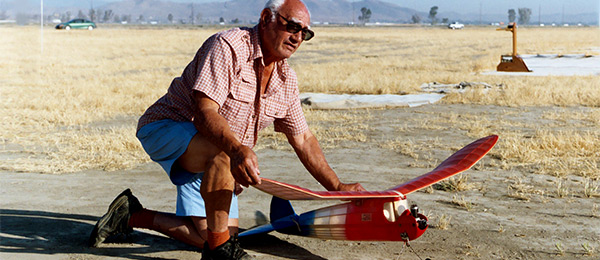
Memorial event draws more than 60 Taibi-designed models Online and tablet app bonus interview with Sal. Photos and article by Kevin Sherman.
Aeromodeling legend Sal Taibi passed away in late December 2012. With only a small family service planned, two members of Sal’s former club, the Southern California Antique Model Plane Society (SCAMPS), thought it would be a good idea to have an event in his honor for his modeling friends. The SCAMPS club holds an annual contest in March in Sal’s honor called the Taibi Annual, but Kevin Sherman and Daniel Heinrich wanted to hold an event that would allow modelers to honor Sal the way he would have liked and not have to wait for his traditional contest. Having a fun-fly in his honor seemed like the perfect idea and the event was scheduled for January 12, 2013. Sal’s son, Mike Taibi, and Sally Moke, Sal’s girlfriend, sent word that they would attend. Sal Taibi started test flying at a field in Perris, California, in the 1960s. He used his test sessions to prepare for contests. A few SCAMPS asked if they could tag along. In time, Sal had a group of fliers joining him each week and flying at Perris every Wednesday became a SCAMPS tradition. Eventually the field was named Taibi Field after Sal. It was decided that a perfect way to honor Sal would be to have a fun-fly in his honor at Taibi Field and the date January 12 was chosen. People were invited to bring their Taibi-designed models for a group picture—and, of course, donuts. If Sal’s first love was model airplanes, his second may have been eating! His stomach was like an alarm clock, telling him when it was time to take a donut break. In time, that alarm clock would go off earlier and earlier until he would call for a donut break at 9 a.m. January 12 approached with conflicting weather forecasts. Some called for strong winds and others predicted winds between 3 and 5 mph. Not in question were the cold temperatures because of an arctic flow. In any case, neither the cold nor the winds that didn’t materialize kept anyone away.
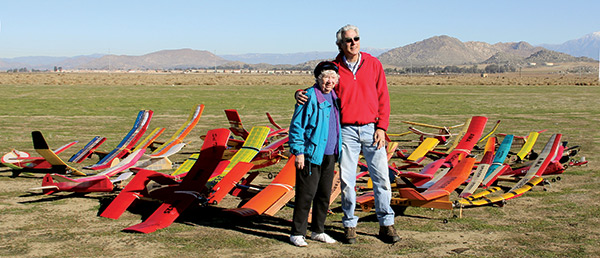 Mike Taibi and Betty Moke stand before the gathering of Taibi-designed models.
Mike Taibi and Betty Moke stand before the gathering of Taibi-designed models.
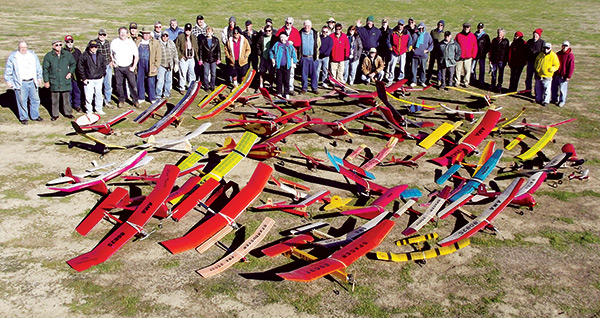 Roughly 70 Taibi models and 45 modelers braved the cold at the Taibi Fun-Fly.
Roughly 70 Taibi models and 45 modelers braved the cold at the Taibi Fun-Fly.
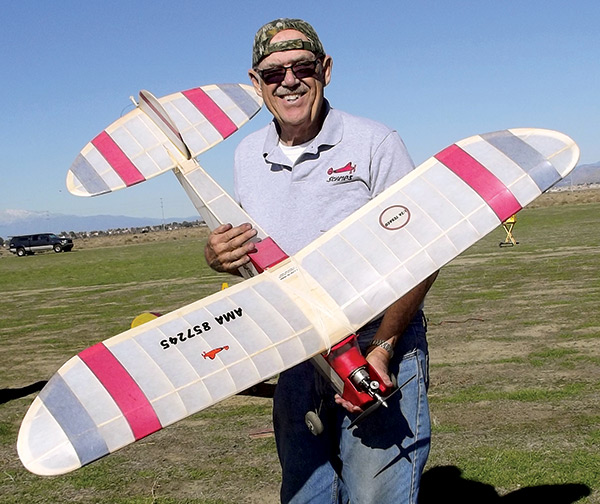 Ray Peel displays his 1/2 A Texaco Powerhouse. The SCAMPS club started the 1/2 A Texaco event and the Powerhouse is one of its most popular models.
Ray Peel displays his 1/2 A Texaco Powerhouse. The SCAMPS club started the 1/2 A Texaco event and the Powerhouse is one of its most popular models.
 Gary Sherman holding Kevin Sherman’s Veco 19-powered, 510-inch Spacer.
Gary Sherman holding Kevin Sherman’s Veco 19-powered, 510-inch Spacer.
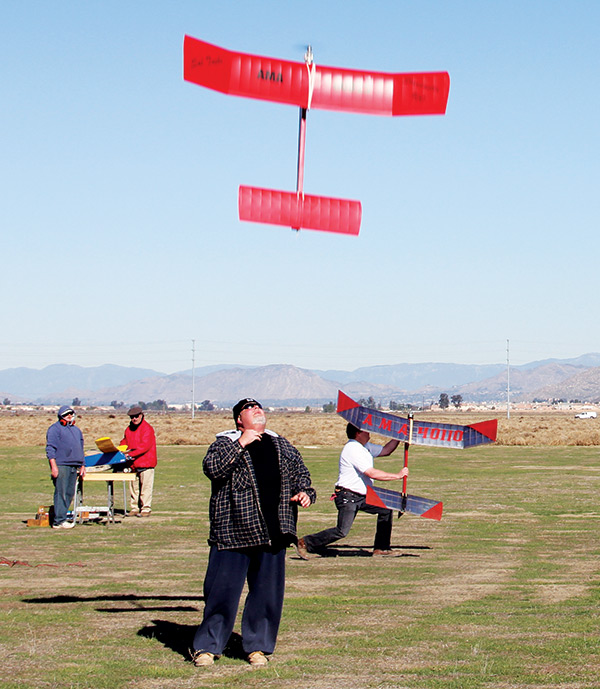 Kevin Sherman launched his father Gary’s Jett .40-powered Starduster 900 during the cold morning at the Sal Taibi Fun-Fly.
Kevin Sherman launched his father Gary’s Jett .40-powered Starduster 900 during the cold morning at the Sal Taibi Fun-Fly.
Daniel Heinrich was first on the field and the Shermans were second. At 7 a.m. it was 27° and the ground was frozen. Walking was a chore because of the ice on the ground. Daniel supplied coffee, purchasing a large coffee pot and carafes, and the hot coffee was a big hit. Kevin brought donuts and somehow more donuts and fruit materialized. There was a photo board collage of Sal and a sign-in sheet made to commemorate the occasion. The photo board will be put out at every Taibi Annual in the future, and the sign-up sheet will be given to Sal’s son, Mike. Approximately 40 people signed in and a large number of Taibi-designed models were in attendance. Kevin, Gary, and Don Sherman all reported having 11 Taibi-designed models in their stables, which seemed like a lot until Joe Jones announced that he had 18! The Shermans managed to load nine of their models into their truck and Joe managed to bring eight. Others including Ted Firster, Jeff Carman, Ken and Don Kaiser, and Ray Peel, had multiples, too. Thanks to social media—in particular the SCAMPS Facebook page—we were able to spread the word about the Taibi fun-fly beyond our membership. Some people who had never built a model, but knew of Sal or had met him attended. A few others came out to the field for the first time, bringing their vintage Taibi models to be included in the group photo. The Facebook page carried event updates. One person even made a photo board from Sal Taibi photos posted on the Facebook page and presented it to Mike Taibi. It was great to see so many of the people Sal touched during his life get behind the event. Flying got off to a late start because of cold weather. One of the first flights was Sal’s own Starduster 900. Sal was known for getting his flights in early in the thick morning air, so it was neat to see the tradition continue with this early morning flight. In Taibi fashion, it made an easy max and DTed from good altitude! After that flight, flying began in earnest. What a joy to see all the Taibi models flying. There were many Stardusters, Spacers, Powerhouses, Brooklyn Dodgers, and Perris Specials tearing up the sky! Ken Kaiser even had an Eaglet cruising around. Sal must have been looking down on us with a big smile on his face! Don Sherman flew two Forster 99-powered Powerhouses. It was fun to see them rise off the ground and climb out. The Forester is a quiet engine, but it puts out a surprising amount of thrust. Jeff Carman also flew a big Powerhouse with a Super Cyke. On his first flight he forgot a rubber band that aided the DT and it failed to pop the tail properly. The model could not decide if it wanted to fly or stall. Eventually it flew into a light spiral, and Jeff was able to get to it, catch it, and get a round of applause for saving the model from any damage. He later stuck it in a nice piece of air and got it up there—at least at least twice as high as before—and this time the DT deployed properly. Because of the late flying start, the schedule was pushed back. Gathering the Taibi models for the group picture began at approximately 9:30 a.m. Sal’s traditional donut break was scheduled for 9 a.m., but people didn’t begin flying until 8, so the donut break never materialized. Food was set out early in the morning, and people ate as they socialized. By 10 a.m. there was a nice group of models present. Don Kaiser reported counting 62, but a few late arrivals and a few who did not make it into the picture put the total of Taibi designs at roughly 70.
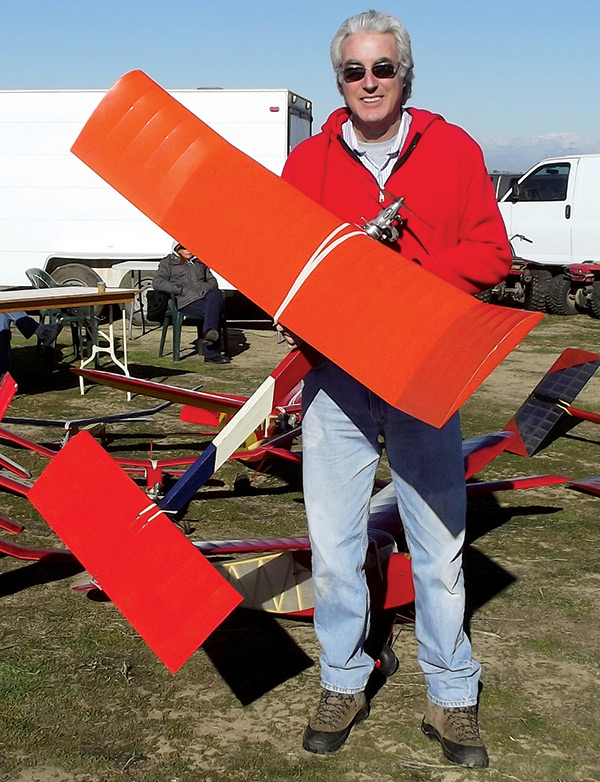 Mike Taibi holds the Starduster 900 Sal built and gave to Kevin Sherman. Sal said the Starduster 900 was his best design of all time.
Mike Taibi holds the Starduster 900 Sal built and gave to Kevin Sherman. Sal said the Starduster 900 was his best design of all time.
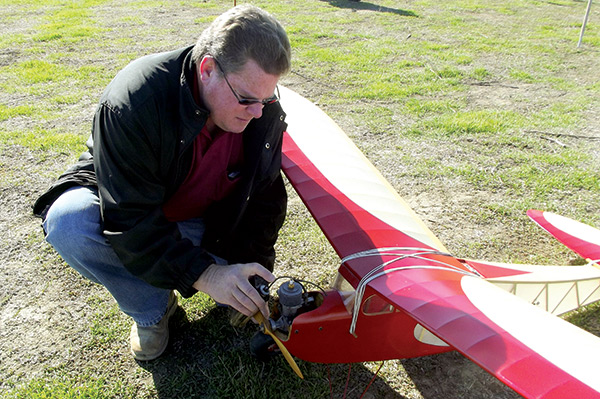 Don Sherman fuels his Forrester .99-powered Taibi Powerhouse.
Don Sherman fuels his Forrester .99-powered Taibi Powerhouse.
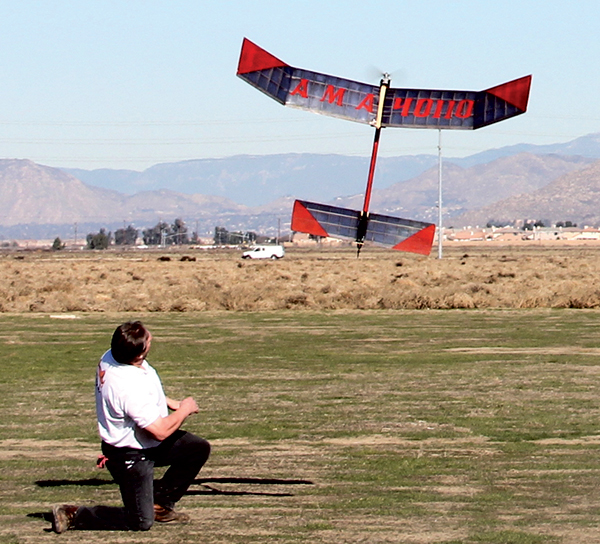 Daniel Heinrich VTOs his 1,000-square-inch Starduster.
Daniel Heinrich VTOs his 1,000-square-inch Starduster.
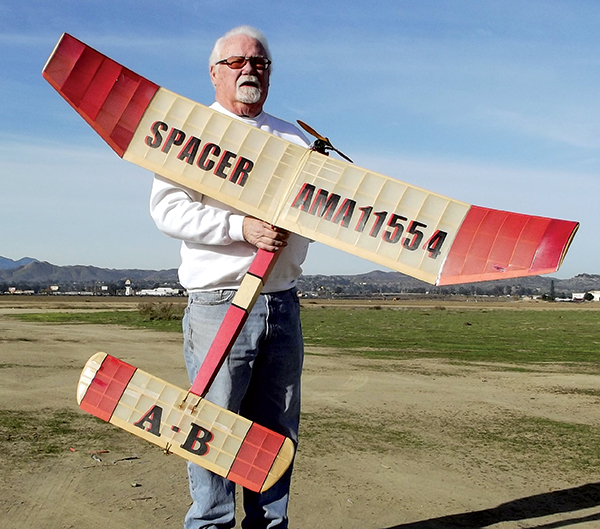 Vic Cunnyngham Jr. displays his contest-winning vintage A/B Taibi Spacer.
Vic Cunnyngham Jr. displays his contest-winning vintage A/B Taibi Spacer.
After we took pictures, Mike Taibi addressed everyone, thanking them for coming and conveyed some nice, touching thoughts. Mike walked around at the end of the day and individually thanked each person who attended. The day was made so much better by his presence and that of Betty Moke, who also thanked everyone. Betty is a wonderful person who had been Sal’s partner for several years. Ted Firster presented Mike and Betty each with shirts from the SAM Champs a few years ago when Sal was also honored. The shirts were imprinted with a picture of Sal launching and Las Vegas in the background. After the group photo shoot, it was back to flying. Everyone was asked to sign in, but several forgot to do so because they were having too much fun flying! After 10 a.m., the weather improved. The temperature rose to the 50s and winds were light and variable. If you judge an event such as this by how much fun people had, then it was a rousing success. Many people talked about what a great time it was and were appreciative that Kevin and Daniel thought to organize the fun-fly. Only Sal could draw a group this large on a freezing day, with a questionable forecast. Sal was a special person, and it was nice to see so many come to honor him. He had an infectious laugh and willingness to help anyone and everyone he could. Although modeling has lost one of its great pioneers, Sal lives on in every Taibi design that is built and flown. Special thanks to the Shermans, Daniel Heinrich, Mark Williams, and everyone else who helped put the event on and all the many others who came out to support it. People are already looking forward to the Taibi Annual at Perris on March 17, 2013. —Kevin Sherman [email protected] SOURCES: SCAMPS http://scamps.homestead.com
Sal Taibi’s 70 Years of Competition
by Kevin Sherman In 2006, Sal Taibi celebrated a great milestone: 70 years of competing in Free Flight. The Southern California Model Plane Society (SCAMPS), a club Sal cofounded, recognized the accomplishment by presenting him with a custom plaque. I took the opportunity to interview Sal and cover some of his modeling history. We met at our SCAMPS’ Perris flying field, affectionately know as “Taibi International,” to discuss some of his experiences throughout those years. The following interview gives some insight into the man and the flier, Sal Taibi KS: How were you first introduced to model airplanes? ST: A friend of mine, Louis, had taken me home to show me his airplane. His mother had knocked it off the piano and broke a couple longerons. He was about to throw it in the trash can and I remember saying, “Louis, don’t do that; give it to me and I’ll take it home and finish it.” It was a Bellanca. I took the model home and I repaired it and flew it until I built my next model which was a 36-inch Rubber ship. I flew the Rubber model, but then decided to go into gas. KS: When did you get real enthused about your modeling? ST: I would say about 1934 or ’35 is when I really got into it with the 36-inch Rubber model. Louis gave me the Bellanca in 1933, and by 1935, I had built a slab-sided Buccaneer, with a Brown Junior. I wasn’t competing with it, but really enjoyed flying it just for fun. At that time, I really didn’t understand everything I was doing. I remember I had to go back to the designer because I couldn’t understand the engine mount. From then on, I designed my own airplanes and that was easy. KS: When did you join the Brooklyn Skyscrapers and how did you find out about them? ST: We originally belonged to a club called TAMBE, which stood for The Airplane Model Builder Exchange. We had a Senior Director who was very dictatorial, with everything having to be done his way. Finally in ’36, four or five of us who were starting to be experienced model builders, broke off from TAMBE and formed the Brooklyn Skyscrapers. KS: You finished your first model airplane in 1933. When did you enter your first contest? ST: It was 1936, when a friend of mine took me to Hadley field in New Jersey. I flew the slab-sided Buccaneer with the Brown and did not place—didn’t even come close. I flew for a few years at several other contests without winning. That is when I decided I wanted to design my own models. KS: How were you introduced to contest flying? ST: The club started to going to contests and they asked me to go along. At the time, I was just flying for fun at a place called the Diker Heights Golf Course in Brooklyn, New York, and I would go there to fly my Buccaneer. I never thought about going to a contest until they had a contest at Hadley Field, New Jersey and they said, “Why don’t you go along.” So I went with them and I enjoyed it and that is when I started building for contests. KS: Were you still with TAMBE, or had you already formed the Skyscrapers. ST: We had already formed the Skyscrapers. KS: Who were your mentors during those early years? ST: Leon Shulman was a big push. He liked to go to contests and I had never been to one, so I went to my first contest with Leon. Of course, there weren’t too many guys in our club who were contest builders or liked to go contests. We all did it for our own enjoyment. But, Leon liked to go to contests and that is when I got started. KS: What led you to design your own models? Did you have any help and how did you learn to design? ST: I wasn’t excited about any of the models that were out there, and thought I could just design my own. Of course, I used Zaic’s Yearbook which gave all the parameters for things like tail moment and stabilizer area versus wing area and so on. So, you might say that Zaic’s Yearbook was my manual from which I designed out of including the Powerhouse, the Dodger, and the Pacer. Of course, after you design half a dozen, everything is in your head and you don’t have to refer back to the book anymore. KS: When did you win your first contest? ST: That was February 12, 1939. I won the Class C endurance contest with a Powerhouse powered by a Forster .99; that was my very first win. I narrowly squeaked past Henry Struck, who was trying to catch me, but his friend drove too fast when they retrieved his model (with a car) and folded the wing. Henry was in a rumble seat holding his Record Hound, and John just drove too fast. We had a field you could drive a car across, and he drove fast enough to snap the wing on Henry’s airplane. KS: You set several records during your 70 years of competition. What was your first and what did you set it with? ST: The first one was August 20th, 1939. I established an ROW [rise-off-water] record at Lake Hopatchong, New Jersey, with a 1 minute, 7 second flight average, flying a Powerhouse with 42-inch-long gondolier floats or pontoons. One other flyer got off the water, but crashed in a few seconds. The only difference from flying off land was that I had to trim my prop to 16 inches. Power was the Forster .99. We had about 20 contestants at the Frank Zaic contest. Frank spent most of the day retrieving models that did not lift off the water! KS: Your late wife Nan was a part of your contest flying. Can you discuss the role she played? ST: She did a lot of timing and a lot of backup timing. As a backup, she would stand there with the timer and when he would punch his watch, she would punch hers. On only one occasion did it really work to have her backing up the timer. I was flying at a Nationals in Kansas and I had made the longest flight of the day, which was only 3½ minutes; the wind was blowing like hell. The timer dropped his watch on the ground and luckily, Nan had her watch going and she gave the timer her watch. It had a loop on it and Nan just looped it around his neck. With 3½ minutes being the longest flight of the day, you can guess how hard the wind was blowing. KS: Did Nan encourage your building? ST: I don’t think she really encouraged me to build. She wasn’t against it either, but sometimes didn’t like the amount of time I was devoting to modeling instead of her (Taibi laughs). In fact, one time I was sanding on a model and she had been watching me out the kitchen window. I had this kind of a model which was planked and I was sanding it and she came out and said, “How come you don’t hold me like that?” So, I put the airplane down, put her on my lap, and I started stoking her. She was then very happy (Taibi laughs again). KS: I know your son, Michael, competed with you at the Nats. Can you discuss the time you guys shared competing? ST: Michael was the 1969 Junior National Champion. We had all of his models ready. Believe it or not, he flew a Starduster 900 at 14 years old and he was good at Towline, and he was good in Rubber. He had a Bilgri stick that would do 5 minutes first thing in the morning without help. I remember telling him before the contest started that I was going to do all the worrying for him. “Now you don’t have to worry about nothing. I’ll do all the worrying, you just fly the airplanes.” That’s what he did. He got a good run in ½A Speed and ½A Proto, good runs in A Speed, flew his Nordic Glider well, and then put in his flights with his Rubber and power ships, and he wound up Champion. He scored more points than any Junior had ever scored in a national competition. He had right around 750 points out of a possible 900. Nobody had ever made more than about 550 points before that. Watching Michael win was as fun and gratifying for me as if I had done it myself. I really enjoyed it. KS: I know you were a past SAM [Society of Antique Modelers] Grand Champion. Do you consider that one of your greatest accomplishments in modeling? ST: Oh yes. It was nice being the SAM Champion. I enjoyed it, but mostly, I enjoyed the guys. The camaraderie and interaction is the fun of it. KS: You designed many airplanes. Which do you consider to be your best? ST: Without a doubt, the Starduster. It just did phenomenal in competition. At one of the early 1960s Nationals, out of 15 places (they placed from first to fifth in those days in Junior, Senior, and Open) the Starduster took 14 out of the 15 places. I think it was the 1961 or ’62 Nationals. KS: You are an accomplished competitor, designer, and have taught hundreds if not thousands to fly Free Flight. What do you consider your greatest accomplishment? ST: Teaching my good friend, Kevin Sherman, to fly (laughing). I don’t know, I guess I would have to say designing the Starduster was the best thing I ever did because it flies in anybody’s hands, novice or an expert. KS: You spent your career as a machinist. Did that help you in modeling? ST: I don’t know if it helped me in modeling, it just helped me to do things that I wanted to do that were impractical as just a model builder. Doing stuff on a lathe or a milling machine to make a model more airworthy, I don’t know. I have made thousands of tanks and tank mounts, and things like that which helped. KS: What was your favorite era to compete in? ST: I would say the 1950s when we went there with a whole bunch of Starduster 900s and wiped out the contest. KS: What is your favorite part of competing? ST: Just watching my airplane up there nice and high, with good altitude and gliding smoothly and maxing out. I enjoy watching the airplanes fly. I really do enjoy that. It is a challenge to make those 5-minute maxes. KS: You developed a strategy of flying early in the morning, as soon as a contest starts. How did that evolve? ST: Especially in California because in California, the air is very good in the mornings and I found this out after living here for a year or two. I found out that the morning air in California was great. Now in Indiana, we never flew officials until maybe 10 a.m. or 11 a.m. until the ground warmed up. Now in California, the morning air may not have lift, but it has good density and the airplane glides better and will max. If you have a reasonably good airplane, you can fly early, make your maxes, and most of the time, without having to chase it a long way because the wind is usually calm in the mornings. KS: Other than your own designs, what is your favorite Old-Timer gas model? ST: The Comet Sailplane, Carl’s Sailplane. It had such a beautiful outline, and that gorgeous elliptical wing. SS: Other than flying model airplanes, did you have any other hobbies? ST: No, I never did anything other than modeling. I just stuck with modeling and never tried anything else. I guess you could say I had a one-track mind. KS: Can you talk about what SAM has meant to you and to the Old-Timer hobby? ST: SAM introduced all the old models back in again and it has allowed many of us to go back to our youth and fly the models we flew in the ’40s. It’s enjoyable, a low-key contest compared to these modern contests where you are flying these airplanes with two and three hp motors and 7-second engine runs. The SAM contests are much more casual and much more enjoyable whether you win or not. SAM has created a contest environment which allows us to just have fun. KS: Why do you think the SAM movement evolved? Were guys unhappy with the direction modeling was going? ST: Yeah, because I went to a couple contests where I was down to 4-second engine runs and that’s not any fun. You start out with 11, you go to 9, you go to 7, you go to 5, then you go to 4. It is challenging, but it’s not fun. SAM modeling is fun. KS: You have obviously won your fair share, and maybe a few other’s fair share (ha, ha) of contests. Is there one piece of advice you could give on what it takes to win? ST: Yes, be prepared. I found out after going to five or six contests and not winning because my timer didn’t work right, or I didn’t bring enough rubber bands, or I didn’t bring enough fuel or the right fuel, or I had weak batteries. All these little things that amount to a win I filed away in my head and I tried to never repeat them again. After eliminating all the mistakes, I started winning. KS: Is that how you came up with your famous toolbox that has everything in it? It seems to be almost magical to me. I have four flight boxes, and still don’t seem to have as much as you have in your one flight box. ST: Yes, eventually I began to have everything I needed in there. KS: I am one of the many you taught to fly Free Flight. Does it give you pleasure to see your pupils succeed? ST: Oh, definitely, definitely. I am always watching and suggesting things if I can to help them including my famous cutting the rudder tab in half and moving only half of it instead of the entire tab, like a vernier tab. It gives enough adjustment without over-adjusting. KS: Is there any goal you set in competing you never achieved? ST: No, I always seemed to get what I wanted. I am very happy with my modeling career and at 86, I am still enjoying it. KS: What is the best prize you ever won at an airplane contest? ST: Believe it or not, at the 1941 Nats, I won $100 cash. That was quite a prize considering I was making $16 a week as the foreman of Mercury Models saw room. I had three guys working for me and I was the head man in the saw room. There were four of us cutting balsawood for the kits for resale. When I won the $100 at the Nats, I was just, well, I felt so rich (laughing)! KS: What was the largest contest you ever flew in? Do you remember how many competitors there may have been? ST: I would say the largest contest I ever flew in was a contest in Chicago in 1941 where there were 1,200 contestants. The Nats started to deteriorate downward after the war started. Now, you get 300-400 and it is a big contest. There was much more participation before World War II. A lot of the guys didn’t come back to modeling after the war, but there were always those few dozen diehards who were going to be flying models for the rest of their lives. They were always there. KS: I know you flew in many consecutive Nationals. When was that streak? ST: I flew my first Nationals in 1939, and went to every one of them until 1989. I put a lot of miles on the Chevy making the annual trips. KS: Do you have a particular contest experience that stands out? ST: Nan and I were at a contest and I was flying a modified 7-foot Pacer. It had the Pacer body and tail, but a different wing—more like the Spacer. I had a McCoy .60 in it. I must have chased it for three to four hours. It was so big. The body was about 5 feet long, and about 1-foot high. It was like chasing a J-3. I made my flight about 3 p.m. and when I got back, it was dark and Nan was still on the model field, sitting on my tool box, waiting for me to come back. KS: What did you chase it with? ST: I chased it in my car, and luckily the roads went the way I needed to go. In fact, I went through one town, Lebanon, Indiana, and I would guess I hadn’t seen the model for about 20 minutes. I drove the direction the model was going which was north and west and I went through town in a zigzag, north-west pattern, trying to follow the flight path of the model even though I couldn’t see it. After a half hour of this, I got out on a country road and thought to myself, “I am going to go 2 miles and get out and look for the model.” I went two miles on the odometer, and when I got out and looked, it was right over my head. It had lost some altitude and looked like it was coming down in a corn field. I had to leave the car and said to myself, “God, don’t let it go up again!” It didn’t and when it hit the corn, I was only about 10 or 15 feet from it. It was about a three hour flight, but because it was so big, it was easy to chase. The roads in Indiana are laid out in one mile squares, so I could go up and over, up and over and stay with the model. When I got back to the field, Nan was waiting for me with the first place trophy. KS: Do you still enjoy to participating in contests? ST: Yes, I still enjoy watching my model ROG and watching it climb out. It still gives a thrill and gets the jollies out. KS: Thanks, Sal. Sal Taibi went on to compete another two years, for a total of an incredible and most likely unduplicated 72 years. Although he passed away in December 2012, the mark he left on the modeling community is indelible. If he didn’t touch your life personally with his kindness and friendship, he most likely did with one of his many successful designs like the Powerhouse, Spacer, or Starduster. Except for FAI fliers, I think one would be hard-pressed to find a Free Flighter out there who has not built one of Sal’s designs. Since the 1960s, Sal was a member of the SCAMPS. He was one of the founding members of that club as well as the Brooklyn Skyscrapers. Sal served as SAM president and was a past SAM champion. He also served as an officer of the SCAMPS for many years. He and Jim Adams seemed as though they swapped being editor and president back and forth for many years. My dad, Gary Sherman, had been an inactive SCAMPS’ member since the 1970s. When I joined the SCAMPS in 1994, my father and I began flying regularly at the field in Perris, California, and have been active since. The reason the SCAMPS fly weekly at Perris is also attributed to Sal. He started practicing and trimming there in the 1960s, and people started to tag along. Flying Wednesdays at Perris is still a SCAMPS tradition. Part of the Wednesday flying experience is the donut break. If Sal’s first love was model airplanes, his second was food! We always knew when it was time for the donut break when Sal’s stomach alarm would go off! My dad and I were lucky enough to have Sal take us under his wing and show us the ropes. It was our first real success in FF and it sure was a lot more fun than crashing everything. During our early experience with the SCAMPS, he helped me trim my ½A Starduster and helped my dad trim a Forster 99-powered Powerhouse. I feel one of Sal’s greatest contributions to FF was his willingness to share his knowledge. I have seen him help hundreds of modelers trim airplanes. If he thought you were a casual flier, he would help get the model to a safe flyable state, and if he knew you were a competitive flier, he would help trim models to a competitive level of maximum performance. As a way of honoring Sal, I have tried to help anyone and everyone who needs help in FF, after his health kept him from that familiar role. It was the best way I knew to honor his legacy. As noted in the interview, Sal enjoyed seeing the success of those he helped. I was lucky enough to win the SAM Champs FF Power grand championship a couple times, and it is a reflection of Sal’s help. When we were at the banquet for my first win, Sal said, “Last year, Walt Huhn thanked me for his win when he got his award.” I was not given the chance to speak, but certainly would have done the same. “Thanks Sal.” It is never too late to say thank you! Sal was active with us until 2008, competing for the last time in March 2008. He flew his final design, the Perris Special. On his last flight ever, the Perris Special got hung up in some power lines and we were unable to retrieve it. We called the power company, but they could not come out until the next day. Daniel Heinrich and I spent a while throwing things at it, but had no luck knocking it down. The next day, we went out to try again, and the model was gone. It had probably fallen down right next to the road and a passerby picked it up and ignored the reward signs Sal had on all his models. My dad and I felt bad and put together a kit for the PS, a Veco 19, a Taibi tank-mount, and a new timer to replace his lost model. A few weeks later, Sal returned everything and said, “I have been out to the shop a few times and just don’t want to build it.” That was the end of his building and flying. Sal lost his wife, Nan, in 2004. She suffered from a variety of health issues. At that time, Sal’s health was extraordinary. He told me he had never even had a surgery and he was in his late 80s. Several years after Nan passed away, Sal’s health also took a downward turn and he was forced to slow down. Unfortunately, the culprit turned out to be a combination of medications he took that did not work well together and dropped his oxygen saturation. After that, he was never quite the same. In late 2005, Sal met his companion, Betty Moke. They travelled to several SAM Champs together and she would drive him to Perris for every Taibi Annual Contest. She took good care of Sal and was a godsend. Everyone appreciates everything she did for him. Also in 2005, I called the Press Telegram, the local newspaper in Sal’s area of Lakewood. I talked to the human interest section editor and told them the most famous modeler in the world lived in her area. I gave her the details and a nice story about Sal was published in the Tuesday, November 1, 2005, issue. Sal said they treated him great, and even left 100 copies on his porch. From what I heard, his children did not know about it until they read it.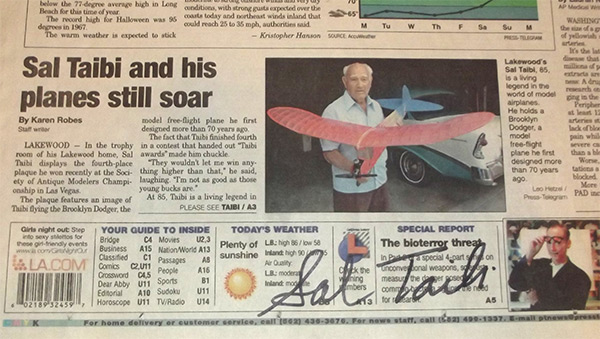 Sal brought copies to Perris and thanked me for setting up the story. I had him sign a copy of the paper for me.
Sal brought copies to Perris and thanked me for setting up the story. I had him sign a copy of the paper for me.
In 2008, he gave me his Starduster 900 with a nice note he wrote on the wing. The 900 was probably his most prized model, and I was honored and surprised he gave it to me. When I knew he was coming out to Perris to watch us fly, I would bring his Duster and put it in the air for him. He said it always gave him a thrill. Hal Wightman and I started a SCAMPS-sponsored contest called the Taibi Annual in 2005. We felt it was past due to have something to honor Sal in the club. The first few contests, we had events like Powerhouse Only, Brooklyn Dodger Only, and Perris Special. Since then, we have featured an All Taibi event, where all of his designs compete against each other. Modern AMA models such as the Starduster, Perris Special, and Orbiteer will fly to current Cat II rules, 9 seconds HL, then 7 in flyoff; Nostalgia-legal designs will fly to currently used SCAMPS Nostalgia rules, 10 seconds HL, 13 VTO, then 7 HL, 9 VTO in flyoff. Old-Timer designs will get a 20 second HL, then 15 in flyoff. All fly to a 3-minute max. The event has proven fun and where else will you see a Powerhouse competing with a Starduster? The 2013 Taibi Annual was March 17 and we kicked off the contest with a flight of Sal’s Starduster 900. Sal became noted as the first in the air at a lot of contests. He liked the buoyant morning air, and we wanted him to be first in the air one more time. I will also fly it as a team with him in the All-Taibi event. Among Sal’s model designs are the Powerhouse, Brooklyn Dodger, Pacer, Winged Yankee, Spacer, Racer, Starduster, Starbuster, Hydrostar, and the Perris Special. Sal kitted several of his models when he owned and operated Competition Models. He also contributed to the hobby in other ways. He formed a large balsawood company called Superior Balsa, based near his home in Lakewood. He designed and manufactured tank mounts for the Cox .020 Tee Dee and the .049/.051 Tee Dee which were made by the thousands. He also designed a simple but effective tank mount for larger engines, and would custom make them for a variety of engines. Sal was an accomplished flier, as evidenced by his trophy room at his modest Lakewood, California, home. The walls were full of records, first-place awards, and of course his SAM Grand Championship trophy. He amassed an amazing number of awards during his 72 years of competition. Sal Taibi was one of the most famous modelers of all time, and the FF community will miss him forever. A small part of Sal will live on as long as a Powerhouse, Brooklyn Dodger, Spacer, or Starduster tears into the sky!










2 comments
los alamitos naval air station navy sponsored nationals
Tomorrow (22/11/2014) I'll be
Add new comment